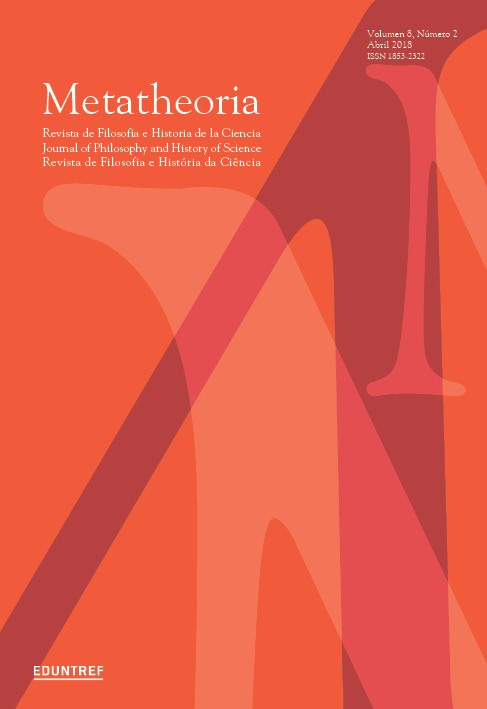Ethics and Life Sciences: a critical analysis of the conceptions about the value of the living in Biology
DOI:
https://doi.org/10.48160/18532330me8.182Keywords:
value of the living, biology, ethicsAbstract
In this paper we analyze the conceptions regarding the value of the living in different biological fields (Molecular Biology, Genetics, Physiology and Conservation Biology). The hypothesis that guided this study is that there might be different assumptions about the value of the living in distinct biological sub-disciplines, and this situation could generate value conflicts within biology. We found that the productive value of organisms (in addition to their value as tools for obtaining knowledge) is widely acknowledged in all the sub-disciplines, while the intrinsic value of the living is only recognized in the area of Conservation Biology. This field of study assigns intrinsic value to species and ecosystems, rejecting intrinsic value of individual organisms. This negation of organisms’ intrinsic value would contribute to avoid conflicts with other biological fields in which utilitarian value of the living prevail. Inquiring about values and assumptions underlying scientific practices is crucial in the current context in which life sciences participate in diverse ethical controversies.
References
Alberts, B., Johnson, A., Lewis, J., Raff, M., Roberts, K. y P. Walter (2007), Molecular Biology of the Cell, 5thedition, New York: Garland Science.
Barbero, S. (2014), La relación entre la neurobiología y la medicina. Un análisis del caso del trastorno por déficit de atención con hiperactividad (ADHD) desde la filosofía de la biología, Tesis de Licenciatura, Buenos Aires: Universidad de Buenos Aires.
Boron, W.F. y E.L. Boulpaep (2012), Medical Physiology. A Cellular and Molecular Approach, 2ndedition, Philadelphia: Saunders.
Bunner, A.E., Chandrasekera, P.C. y N.D. Barnard (2014), “Knockout Mouse Models of Insulin Signaling: Relevance Past and Future”, World Journal Diabetes 5(2): 146-59.
Callicott, J.B. (1990), “Whither Conservation Ethics?”, Conservation Biology4: 15-20.
Chakravartty, A. (2015), “Scientific Realism”, The Stanford Encyclopedia of Philosophy. Accesible en: http://plato.stanford.edu/archives/fall2015/entries/scientific-realism/.
de Boo, J. y A. Knight (2008), “Increasing the Implementation of Alternatives to Laboratory Animal Use”, Alternatives to Animal Testing and Experimentation13(3): 109-117.
de Martínez, C.A.C., de Osorio, A.M., Martínez, C., Yunta, E.R. y F.L. Stepke (2007), El animal como sujeto experimenta. Aspectos técnicos y éticos, Santiago de Chile: CIEB, Universidad de Chile.
Echeverría, J. (2003), La revolución tecnocientífica, Madrid: Fondo de Cultura Económica.
Elliott, K.C. y D.J. McKaughan (2014), “Nonepistemic Values and the Multiple Goals of Science”, Philosophy of Science 81(1): 1-21.
Fernández Chaves, F. (2002), “El análisis de contenido como ayuda metodológica para la investigación”, Ciencias sociales2(96): 33-54.
García Palacios, E.M., Galbarte, J.C.G., Cerezo, J.A.L., Luján, J.L., Gordillo, M.M., Osorio, C. y C. Valdés (2001), Ciencia, Tecnología y Sociedad: una aproximación conceptual, Madrid: Organización de Estados Iberoamericanos para la Educación, la Ciencia y la Cultura.
Griffiths, A.J.F., Wessler, S.R., Carroll, S.B. y J. Doebley (2010), Introduction to Genetic Analysis, 10thedition, New York: WH Freeman.
Groom, M.J., Meffe, G.K. y R.Carrol (2006), Principles of Conservation Biology, 3rdedition, Sunderland, MA: Sinauer Associates.
Gudynas, E. (2009), El mandato ecológico. Derechos de la Naturaleza y políticas ambientales en la nueva Constitución, Quito: Abya Yala.
Gudynas, E. (2015), Derechos de la Naturaleza, Buenos Aires: Tinta Limón.
Heler, M. (1996), Ética y ciencia: la responsabilidad del martillo, Buenos Aires: Biblos.
Hickman, C.P., Roberts, L.S. y A. Larsen (2006), Principios integrales deZoología, 13ª edición, Madrid: McGraw-Hill Interamericana.
Hunter, M. y J. Gibbs (2007), Fundamentals of Conservation Biology, Oxford: Blackwell Publishing.
Kincaid, H., Dupré, J. y A. Wylie (eds.)(2007), Value-Free Science: Ideals and Illusions?, Oxford: Oxford University Press.
Klug, W.S., Cummings, M.R., Spencer, C.A. y M.A. Palladino (2012), Concepts of Genetics, 10thedition, San Francisco: Pearson Education Inc.
Lewin, B. (1999), Genes VII, 7thedition, Oxford: Oxford University Press.
Linares, J.E. (2008), Ética y mundo tecnológico, México: Fondo de Cultura Económica.
Lindenmayer, D. y M. Burgman (2005), Practical Conservation Biology, Collingwood: CSIRO Publishing.
López Noguero, F. (2002), “El análisis de contenido como método de investigación”, En clave pedagógica4: 167-180.
Maingueneau, D. (1996), “El ethos y la voz de lo escrito”, Versión 6: 79-92.
Marcuse, H. (1985), El hombre unidimensional. Ensayo sobre la ideología de la sociedad industrial avanzada, Barcelona: Planeta-Agostini.
Piñuel, J. (2002), “Epistemología, metodología y técnicas de análisis de contenido”, Estudios de Sociolingüística 3(1): 1-42.
Purves, D., Augustine, G.J., Fitzpatrick, D., Hall, W.C., LaMantia, A.S. y L.E.White (2012), Neuroscience, 5thedition, Sunderland, MA: Sinauer Associates Inc.
Randall, D., Burggren, W.W. y K. French (2001), Eckert Animal Physiology: Mechanisms and Adaptations, 5thedition, New York: W. H. Freeman.
Reiss, J. y J. Sprenger (2014), “Scientific Objectivity”, The Stanford Encyclopedia of Philosophy. Accesible en: http://plato.stanford.edu/archives/fall2014/entries/scientific-objectivity/.
Rodríguez Alcázar, F.J. (1997), “Esencialismo y neutralidad científica”, en Rodríguez Alcázar, F.J., Medina Doménech, R.M. y J. Sánchez Cazorla (eds.), Ciencia, tecnología y sociedad: Contribuciones para una cultura de paz, Granada: Editorial Universidad de Granada, pp. 49-84.
Taylor, P.W. (1986), Respect for Nature: A Theory of Environmental Ethics, Princeton: Princeton University Press.
Van Dyke, F. (2008), Conservation Biology. Foundation, concepts, applications, 2ndedition,New York: Springer.
Downloads
Published
How to Cite
Issue
Section
License
Copyright (c) 2018 Metatheoria – Journal of Philosophy and History of ScienceThe documents published here are governed by the licensing criteria
Creative Commons Argentina.Atribución - No Comercial - Sin Obra Derivada 2.5 https://creativecommons.org/licenses/by-nc-nd/2.5/ar/





